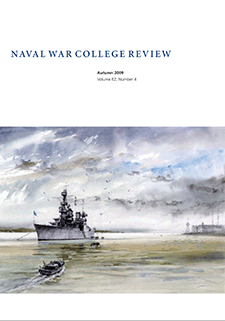Naval War College Review
Volume 62, Number 4 (2009) Autumn
USS Augusta in Narragansett Bay, 2 May 1941, a watercolor painting by the marine artist Ian Marshall. The scene shows the heavy cruiser USS Augusta (CA 31) on the day that Admiral Ernest J. King broke his four-star flag in Augusta as Commander in Chief, U.S. Atlantic Fleet. The ship is moored to a buoy on the Jamestown side of the bay (that is, near Conanicut Island, visible to the left), Admiral King’s preferred location; the Naval War College and a signal tower next to Pringle Hall are in the distant background (to the right), and two ship’s boats are approaching—perhaps from the Newport, Rhode Island, fleet landing, or from other ships—to join three already riding to a boom. The cruiser was to be in Newport nearly continuously until January 1942, when King became Chief of Naval Operations. The tower and the tall antennas visible beyond the College complex were removed in the 1960s and ’70s.
Full Issue
Full Autumn 2009 Issue
The U.S. Naval War College
From the Editors
From the Editors
Carnes Lord
President's Forum
President’s Forum—Taking Stock
James Wisecup
Articles
U.S. Naval Options for Influencing Iran
Daniel Gouré and Rebecca Grant
The New Security Drama in East Asia—The Responses of U.S. Allies and Security Partners to China’s Rise
Evan S. Medeiros
Using the Land to Control the Sea?—Chinese Analysts Consider the Antiship Ballistic Missile
Andrew S. Erickson and David D. Yang
China’s Antiship Ballistic Missile—Developments and Missing Links
Eric Hagt and Matthew Durnin
Clear Purpose, Comprehensive Execution—Raymond Ames Spruance (1886–1969)
Wayne P. Hughes Jr.
Midway and the Indian Ocean
Jeremy Black
Fresh Thinking for an Old Problem—Report of the Naval War College Workshop on Countering Maritime Piracy
James Kraska JAGC
More than Three Laws of Robotics
John Edward Jackson and P. W. Singer
Ivory Tower Meets James Bond
David C. Foley, Roger George, and James Bruce
Book Reviews
A Leader Becomes a Leader: Inspirational Stories of Leadership for a New Generation
Richard Norton and J. Kevin Sheehan
Small Boats, Weak States, Dirty Money: Piracy and Maritime Terrorism in the Modern World
Claude Berube and Martin N. Murphy
Fighting Identity: Sacred War and World Change
S. Mike Pavelec and Michael Vlahos
Spying on the Nuclear Bear: Anglo-American Intelligence and the Soviet Bomb
Myron Greenberg and Michael S. Goodman
Russian Civil-Military Relations: Military Strategy and Operational Art
Tom Fedyszyn and Robert Brannon
The Third Reich at War
Stephen Knott and Richard J. Evans
If Mahan Ran the Great Pacific War: An Analysis of World War II Naval Strategy
Michael Pearlman and John A. Adams
The Late Victorian Navy: The Pre-dreadnought Era and the Origins of the First World War
John B. Hattendorf and Roger Parkinson
Reflections on Reading
Reflections on Reading
John E. Jackson
Additional Writing
In My View
James Goldrick

Credit
The painting was commissioned by the Naval War College Museum, using funds provided by the Naval War College Foundation, to record a local scene not otherwise visually recorded in the Museum’s collections. The painting, delivered on 29 September 2008, hung in the Museum’s Predators and Guard Dogs: An Exhibit of the Works of Ian Marshall from 12 February to 30 June 2009 and then joined the permanent collection, in a new display case installed through the generosity of Robert Alvine’s gift to the Foundation and Museum.
Born in Fife, Scotland, and originally trained as an architect, Ian Marshall lives today on Mount Desert Island in Maine. He is the author of five books illustrated by his meticulously accurate historical ship paintings, and his work hangs in the permanent collections of many museums in the United States and Europe.

